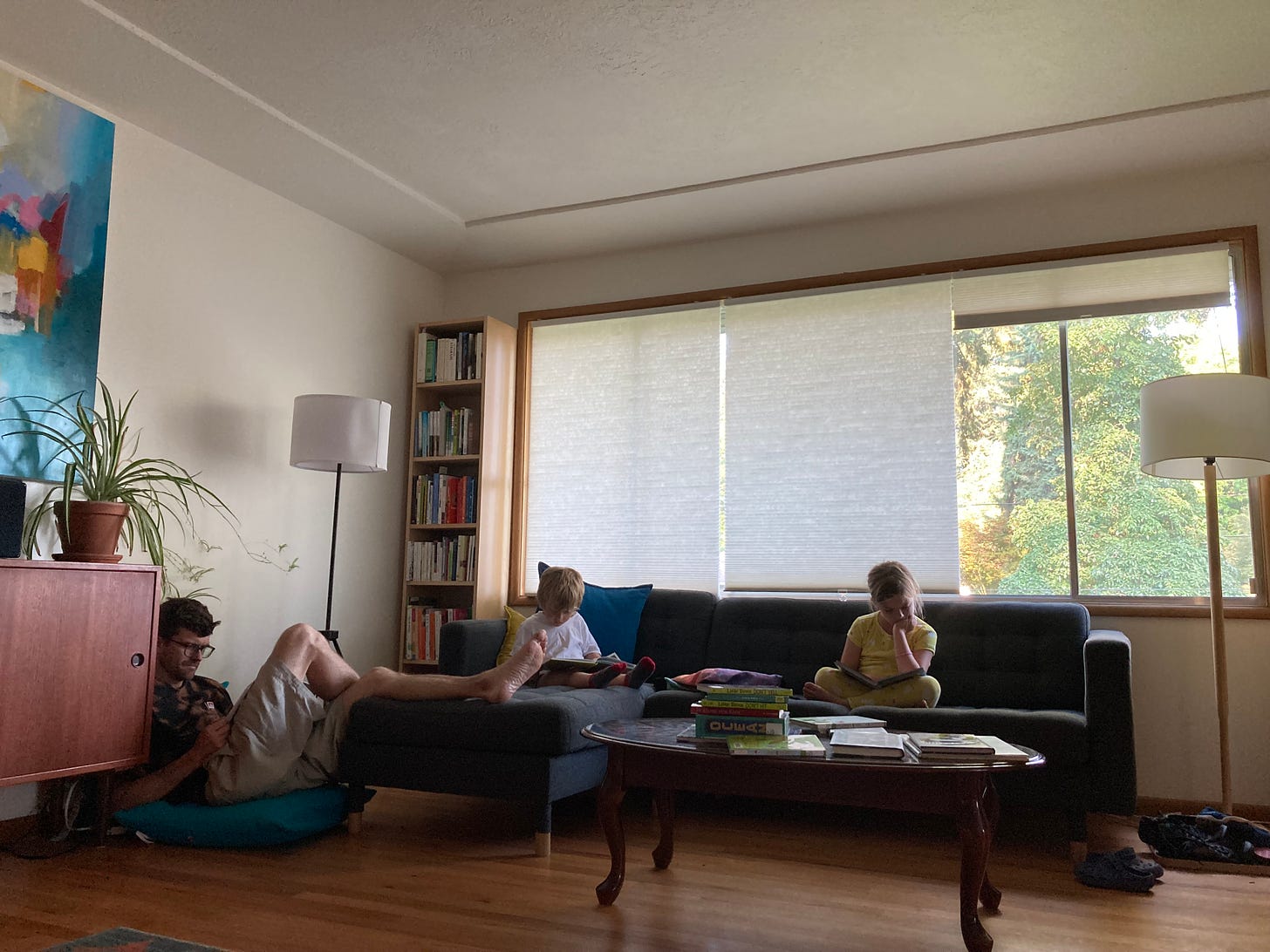August 29, 2022
When Sister Protasia planted the sapling beside Mt Angel monastery in 1893, she had no idea what kind of tree it was. 130 years later, the giant sequoia is over 130 feet tall. I look up in complete awe of its width, its height, its sheer presence before me. Pictures don’t do it justice. Some of its limbs bend down to earth and run upward again, wider than the trunks of trees in my yard at home. It towers over the monastery’s brick edifice, its peak rising higher than the cross on top of its steeple, still growing imperceptibly taller every day, even now.
A giggle escapes my chest when I read how the sister had dug up the sapling from beside the railroad tracks, shortly after her Benedictine community had moved from Switzerland to Gervais, Oregon, then finally to the open plain at the base of Mt Angel that would become their home.
She didn’t know the tree’s potential, the capacity for greatness written into its genes. Yet it didn’t get this way overnight. Each day, minute by minute, it did what it was made to do, what it could only do: become itself.
Home after two nights in retreat, I hum the melody of a psalm, lingering in my ear after Sunday Mass. The sisters’ voices were thin and high, not all of them in tune, but beautiful together as they sang the liturgy of the hours. Bells rang each day, striking each hour and then each quarter, so that I abandoned my watch, setting my inner clock by the rhythm of their prayers. I’d cross the courtyard from the little house behind the monastery and climb the stairs to the chapel, finding the right prayer book from the shelf, struggling to find the next prayer, joining my voice with theirs.
Sister Protasia, of course, is long gone. The numbers of the faithful taking vocations has dwindled, and most of the sisters are in their 80s, many in wheelchairs or pushing walkers. It would be simple to underestimate their strength. It would be easy to see the daily and yearly rhythm of prayer— morning, noon, and evening, vesper and vigil, feasts and ordinary time— as unremarkable, repetitive. Many hold this opinion. What does it mean that there are sisters and brothers like them, all over the world? Is monastic life still relevant? Do their prayers matter, and the life of service that grows from them?
I think their prayers matter the way the giant sequoia matters, in a way that is beyond inches and feet and years. Sitting and standing, bowing and making the sign of the cross in the chapel, I feel the strength of each prayer. It’s a measure of history, of people who have used their lives to grow their collective faith, an uninterrupted stream. How do you measure one psalm, one prayer, one person’s life in the great current?
We live lives shaped by measurement, bound by time. Micha Boyett’s recent letter “Time is a Gift of Love” profoundly explores the moral implications of a culture obsessed with what can be produced by time. When we value time for what it produces, there’s the danger, all too real, of dismissing the integrity of a life.
So there’s a wonderful subversiveness in the liturgy of the hours, a kind of holy mischief about each prayer as it leads beyond time, imperceptibly stepping toward eternity. At Mt Angel, I stepped outside of time for a while. I prayed and sang, I walked in the sunshine and marveled at a tree. I drank Earl Grey and sat on a sofa and read several books straight through. I rested. I cried and I laughed, and I spent time— I gave time— to just feeling the joy of my love for Jesus.
And then I came back to the three precious lives God has given me to steward, little saplings whose full capacity I don’t know, mother though I am to them. I came home to the complicated layers of their needs, and the complicated feelings I have about my incapacity to meet all of those needs.
One little one wrapped around my leg, another one plinking away on the piano, and our oldest asking me to watch her dance, I inched my way to the microwave, a package of minute rice in my hands. That’s beautiful, love, I said, squishing and smooshing the rice in the packet, tearing open the corners and pressing the button three times to make 90 seconds.
I am not a perfect mother. I am humbled every day by the magnitude of the task, by the way my ideals—thankfully— give way to the real. I can’t grow a sequoia, can’t promise not to make mistakes, to lose my patience and forget my joy, to fall victim again to the trap of believing time is the most important thing.
But I can make minute rice. I can water a seedling. I can pray.
Sending love to you,
Melissa
Reading + Writing
My kids have always loved books, but this summer there’s been a lot more wandering off to find a quiet place to read. Especially with the long, light evenings, this is a typical post-dinner scene in our home. It makes me so happy.
Sky learned to read last year in first grade, and now she picks up just about everything! She happily reads aloud to Robin and Iris, but she also likes being read to. This summer we have been working our way through the Chronicles of Narnia series, starting with The Lion the Witch and the Wardrobe. I didn’t read these growing up, so I’m as engaged as the kids are in following the plot, and noticing clues and connections to the other books as we go. Other summer bedtime favorites have been Skater Baby, The Problem with Pajamas, and Emile in the Field.
A few other highlights:
Rainbow Crow. Fellow Project Redux contributor Megan Willome’s new release is a children’s book of poetry about crows. Rainbow Crow has beautiful illustrations and poems in a wide variety of forms. I think that’s been our favorite part of reading it together! This book respects kids’ intelligence, and their ability to appreciate more complex language.
Parenting Devotionals. A theme in my own reading this year has been the discovery of devotionals geared toward mothers. I read and loved Catherine McNiel’s Long Days of Small Things several years ago, but hadn’t found more books in that style until recently. I discovered Small Steps for Catholic Moms via an old post on a favorite blog, and found both a used copy of the book and a guided journal companion on Thriftbooks. (Do you know about Thriftbooks? It’s been such a great budget-friendly resource for books we can’t get at the library!) Each month focuses on developing a different virtue, like patience, love, and humility. I’ve loved the “action steps” for each day, with suggestions for crafts to work on with kids or simple ways to find rest in the middle of busy days. It’s also been a helpful companion as I continue to explore the Catholic faith.
Samantha Stephenson’s devotional Mama Prays has been similarly grounding. She sent me a copy in the mail, and even though it’s intended as a daily devotional, I pretty much didn’t put it down after I’d taken it out of the envelope. Samantha’s writing brings new life to familiar scenes from the challenges of mothering small children. It’s beautifully written, and with such a deep sense of care for the reader.
This month I’ve also been reading through Parenting Scripts in an online book group. I’ve read A LOT of parenting books— so much so that I’m totally burnt out on the idea of a “method” to raising kids. I love how this one combines prayerful reflection l with a practical approach to parenting. It is teaching me how to speak truth to myself as a parent before I speak to my kids. By bringing scripture into my reflections on things that aren’t working well at the moment, I am reminded to seek God’s will, not my own, as I parent them. It’s simple and yet it’s been quite profound in shaping the culture of our home.
All things Sigrid Undset. My recent posts for Project Redux include this one on character and second chances, and this one on the many nameless diseases in Kristin Lavransdatter, through the lens of warm disease theory in Chinese medicine. Alongside the Kristin trilogy for which she is best known, I recently read her “modern” (1930s) novel-in-two-parts Wild Orchid and Burning Bush, and a brand new biography, Sigrid Undset: Reader of Hearts. Now I am digging into part one of Olav Audunsson, her four-part medieval epic, drafted at the beginning of her writing career, but not published until her final years.
Eating
Creamy broccoli pasta from Little Green Kitchen was a huge hit with our hard-to-please middle child. (We made it with multi-colored rotini and sour cream in place of creme fraiche.) He actually said, unprompted, “I love this,” while shoveling forkfuls into his mouth. Unheard of.
I also really loved the essays at the beginning of the cookbook. The authors are parents themselves, and share how they encourage healthy eating at home by focusing on fun, health, and energy. How many colors did you eat today? I wonder how fast we’ll be able to run after we eat this spinach? This reframe has helped ease some of the tension around meals with Robin, who needs to be on the go and is generally wary of new tastes, textures, and colors.
P.S. My friend Lee is relaunching My Wings, imaginative wear for children with a heart for nurturing their inner strength. We have the “jungle butterfly” wings at home, and each of our kids has gotten so much joy from them. Please visit Lee’s Indiegogo page! The holidays will be here before we know it, and My Wings make an affordable, super cute gift for little ones.







I've always wondered about Long Days of Small Things! I might have to get it. I also enjoyed Parenting Scripts and have been going back through it again (although admittedly not keeping up with the online group). :)